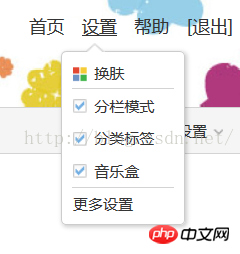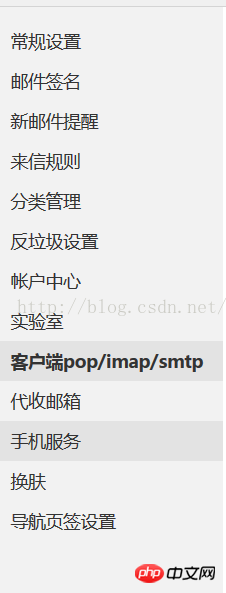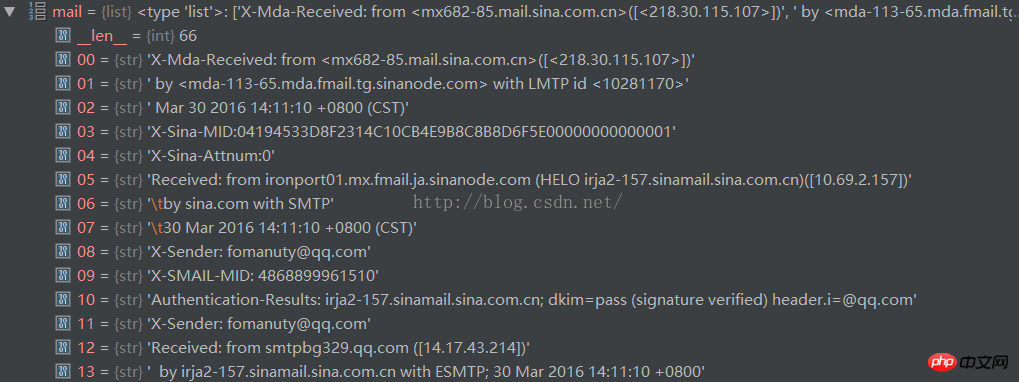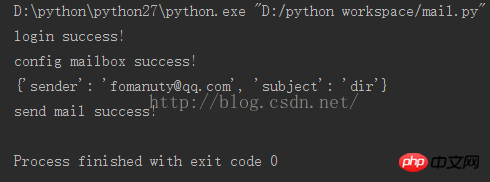 Backend Development
Backend Development
 Python Tutorial
Python Tutorial
 Simple implementation of the function of sending and receiving emails in Python
Simple implementation of the function of sending and receiving emails in Python
Simple implementation of the function of sending and receiving emails in Python
This article mainly teaches you how to simply implement the function of sending and receiving emails in python. The key points of knowledge are the use of python's built-in poplib and stmplib modules. It has certain reference value. Interested friends can refer to it. I hope it can help everyone.
1. Preparation
First of all, we need to have a test email. We use Sina Email and make the following settings:

Find Settings->More Settings in the upper right corner of the Sina Mail homepage, and then select "Client/pop/imap/smtp" on the left:

Finally, turn on the service status of the Pop3/smtp service:

2. poplib receives mail
First , introduce some interfaces for poplib login mailbox and download mail:
self.popHost = 'pop.sina.com' self.smtpHost = 'smtp.sina.com' self.port = 25 self.userName = 'xxxxxx@sina.com' self.passWord = 'xxxxxx' self.bossMail = 'xxxxxx@qq.com'
We need some constants as above to specify the login mailbox and pop, smtp server and port. We call poplib's POP3_SSL interface to log in to the mailbox.
# 登录邮箱 def login(self): try: self.mailLink = poplib.POP3_SSL(self.popHost) self.mailLink.set_debuglevel(0) self.mailLink.user(self.userName) self.mailLink.pass_(self.passWord) self.mailLink.list() print u'login success!' except Exception as e: print u'login fail! ' + str(e) quit()
When logging in to the mailbox, it is natural that we need to provide a username and password. As shown in the above code, it is very simple to use.
After successfully logging in to the mailbox, we can use the list method to obtain the mail information of the mailbox. We see the definition of the list method:
def list(self, which=None): """Request listing, return result. Result without a message number argument is in form ['response', ['mesg_num octets', ...], octets]. Result when a message number argument is given is a single response: the "scan listing" for that message. """ if which is not None: return self._shortcmd('LIST %s' % which) return self._longcmd('LIST')
We see the comment of the list method, whose Chinese meaning is that the list method has a default parameter which, and its default value is None when the caller does not give a parameter. , this method will list the information of all emails, and its return form is [response, ['msg_number, octets', ...], octets], where response is the response result, msg_number is the email number, and octets is an 8-bit word section unit. Let's take a look at a specific example:
('+OK ', ['1 2424', '2 2422'], 16)
This is the return result after calling the list() method. Obviously, this is a tuple. The first value sahib responds with '+OK', indicating that the request is successful. The second value is an array that stores the email information. For example, 1 in '1 2424' means that the email number is 1.
Let’s look at how to use poplib to download emails.
# 获取邮件
def retrMail(self):
try:
mail_list = self.mailLink.list()[1]
if len(mail_list) == 0:
return None
mail_info = mail_list[0].split(' ')
number = mail_info[0]
mail = self.mailLink.retr(number)[1]
self.mailLink.dele(number)
subject = u''
sender = u''
for i in range(0, len(mail)):
if mail[i].startswith('Subject'):
subject = mail[i][9:]
if mail[i].startswith('X-Sender'):
sender = mail[i][10:]
content = {'subject': subject, 'sender': sender}
return content
except Exception as e:
print str(e)
return Nonepoplib’s interface for obtaining email content is the retr method. It requires one parameter, which is the email number to be obtained. The following is the definition of the retr method:
def retr(self, which): """Retrieve whole message number 'which'. Result is in form ['response', ['line', ...], octets]. """ return self._longcmd('RETR %s' % which)
We see the comments and we can know that the retr method can obtain the entire content of the email with the specified number, and its return form is [response, ['line', ...] , octets], it can be seen that the content of the email is stored in the second element of the returned tuple, and its storage form is an array. Let's test what this array looks like.

We can see that the storage form of this array is similar to a dict! So, we can find anything we are interested in based on this. For example, if our sample code is to find the subject and sender of the email, it can be written as the above code. Of course, you can also use regular matching~~~ Here are the test results:

Well...you can try it yourself.
3. Smtp sends mail
Like pop, you must provide it with some required constants before using smtp:
self.mail_box = smtplib.SMTP(self.smtpHost, self.port) self.mail_box.login(self.userName, self.passWord)
The above is the code for logging in to the mailbox using smtp, which is similar to pop. The code for sending emails using SMTP is given below. You will see how simple and beautiful Python is!
# 发送邮件 def sendMsg(self, mail_body='Success!'): try: msg = MIMEText(mail_body, 'plain', 'utf-8') msg['Subject'] = mail_body msg['from'] = self.userName self.mail_box.sendmail(self.userName, self.bossMail, msg.as_string()) print u'send mail success!' except Exception as e: print u'send mail fail! ' + str(e)
This is the code for python to use smtp to send emails! It's very simple! Very convenient! Very easy to understand! The main method here is sendmail. Just specify the sender, receiver and email content. There is also MIMEText, which can be defined as follows:
class MIMEText(MIMENonMultipart):
"""Class for generating text/* type MIME documents."""
def __init__(self, _text, _subtype='plain', _charset='us-ascii'):
"""Create a text/* type MIME document.
_text is the string for this message object.
_subtype is the MIME sub content type, defaulting to "plain".
_charset is the character set parameter added to the Content-Type
header. This defaults to "us-ascii". Note that as a side-effect, the
Content-Transfer-Encoding header will also be set.
"""
MIMENonMultipart.__init__(self, 'text', _subtype,
**{'charset': _charset})
self.set_payload(_text, _charset)See the comments~~~ This is just a method to generate a MIME document with specified content and specified encoding. By the way, let’s take a look at the sendmail method~~~
def sendmail(self, from_addr, to_addrs, msg, mail_options=[],
rcpt_options=[]):
"""This command performs an entire mail transaction.
The arguments are:
- from_addr : The address sending this mail.
- to_addrs : A list of addresses to send this mail to. A bare
string will be treated as a list with 1 address.
- msg : The message to send.
- mail_options : List of ESMTP options (such as 8bitmime) for the
mail command.
- rcpt_options : List of ESMTP options (such as DSN commands) for
all the rcpt commands.Well...that’s about it for sending emails using smtp.
4. Source code and testing
# -*- coding:utf-8 -*-
from email.mime.text import MIMEText
import poplib
import smtplib
class MailManager(object):
def __init__(self):
self.popHost = 'pop.sina.com'
self.smtpHost = 'smtp.sina.com'
self.port = 25
self.userName = 'xxxxxx@sina.com'
self.passWord = 'xxxxxx'
self.bossMail = 'xxxxxx@qq.com'
self.login()
self.configMailBox()
# 登录邮箱
def login(self):
try:
self.mailLink = poplib.POP3_SSL(self.popHost)
self.mailLink.set_debuglevel(0)
self.mailLink.user(self.userName)
self.mailLink.pass_(self.passWord)
self.mailLink.list()
print u'login success!'
except Exception as e:
print u'login fail! ' + str(e)
quit()
# 获取邮件
def retrMail(self):
try:
mail_list = self.mailLink.list()[1]
if len(mail_list) == 0:
return None
mail_info = mail_list[0].split(' ')
number = mail_info[0]
mail = self.mailLink.retr(number)[1]
self.mailLink.dele(number)
subject = u''
sender = u''
for i in range(0, len(mail)):
if mail[i].startswith('Subject'):
subject = mail[i][9:]
if mail[i].startswith('X-Sender'):
sender = mail[i][10:]
content = {'subject': subject, 'sender': sender}
return content
except Exception as e:
print str(e)
return None
def configMailBox(self):
try:
self.mail_box = smtplib.SMTP(self.smtpHost, self.port)
self.mail_box.login(self.userName, self.passWord)
print u'config mailbox success!'
except Exception as e:
print u'config mailbox fail! ' + str(e)
quit()
# 发送邮件
def sendMsg(self, mail_body='Success!'):
try:
msg = MIMEText(mail_body, 'plain', 'utf-8')
msg['Subject'] = mail_body
msg['from'] = self.userName
self.mail_box.sendmail(self.userName, self.bossMail, msg.as_string())
print u'send mail success!'
except Exception as e:
print u'send mail fail! ' + str(e)
if __name__ == '__main__':
mailManager = MailManager()
mail = mailManager.retrMail()
if mail != None:
print mail
mailManager.sendMsg()The above code first logs in to the mailbox, then gets the first email and deletes it, and then gets the subject of the email and the sender and print it out, and finally send a successful email to another bossMail mailbox.
The test results are as follows:

Okay, you can copy the above code and play with it yourself
Related recommendations:
python to send and receive emails
thinkphp implements 163, QQ mailbox method to send and receive emails_PHP
The above is the detailed content of Simple implementation of the function of sending and receiving emails in Python. For more information, please follow other related articles on the PHP Chinese website!

Hot AI Tools

Undresser.AI Undress
AI-powered app for creating realistic nude photos

AI Clothes Remover
Online AI tool for removing clothes from photos.

Undress AI Tool
Undress images for free

Clothoff.io
AI clothes remover

Video Face Swap
Swap faces in any video effortlessly with our completely free AI face swap tool!

Hot Article

Hot Tools

Notepad++7.3.1
Easy-to-use and free code editor

SublimeText3 Chinese version
Chinese version, very easy to use

Zend Studio 13.0.1
Powerful PHP integrated development environment

Dreamweaver CS6
Visual web development tools

SublimeText3 Mac version
God-level code editing software (SublimeText3)

Hot Topics
 1386
1386
 52
52
 Can visual studio code be used in python
Apr 15, 2025 pm 08:18 PM
Can visual studio code be used in python
Apr 15, 2025 pm 08:18 PM
VS Code can be used to write Python and provides many features that make it an ideal tool for developing Python applications. It allows users to: install Python extensions to get functions such as code completion, syntax highlighting, and debugging. Use the debugger to track code step by step, find and fix errors. Integrate Git for version control. Use code formatting tools to maintain code consistency. Use the Linting tool to spot potential problems ahead of time.
 How to run programs in terminal vscode
Apr 15, 2025 pm 06:42 PM
How to run programs in terminal vscode
Apr 15, 2025 pm 06:42 PM
In VS Code, you can run the program in the terminal through the following steps: Prepare the code and open the integrated terminal to ensure that the code directory is consistent with the terminal working directory. Select the run command according to the programming language (such as Python's python your_file_name.py) to check whether it runs successfully and resolve errors. Use the debugger to improve debugging efficiency.
 Can vs code run in Windows 8
Apr 15, 2025 pm 07:24 PM
Can vs code run in Windows 8
Apr 15, 2025 pm 07:24 PM
VS Code can run on Windows 8, but the experience may not be great. First make sure the system has been updated to the latest patch, then download the VS Code installation package that matches the system architecture and install it as prompted. After installation, be aware that some extensions may be incompatible with Windows 8 and need to look for alternative extensions or use newer Windows systems in a virtual machine. Install the necessary extensions to check whether they work properly. Although VS Code is feasible on Windows 8, it is recommended to upgrade to a newer Windows system for a better development experience and security.
 Is the vscode extension malicious?
Apr 15, 2025 pm 07:57 PM
Is the vscode extension malicious?
Apr 15, 2025 pm 07:57 PM
VS Code extensions pose malicious risks, such as hiding malicious code, exploiting vulnerabilities, and masturbating as legitimate extensions. Methods to identify malicious extensions include: checking publishers, reading comments, checking code, and installing with caution. Security measures also include: security awareness, good habits, regular updates and antivirus software.
 What is vscode What is vscode for?
Apr 15, 2025 pm 06:45 PM
What is vscode What is vscode for?
Apr 15, 2025 pm 06:45 PM
VS Code is the full name Visual Studio Code, which is a free and open source cross-platform code editor and development environment developed by Microsoft. It supports a wide range of programming languages and provides syntax highlighting, code automatic completion, code snippets and smart prompts to improve development efficiency. Through a rich extension ecosystem, users can add extensions to specific needs and languages, such as debuggers, code formatting tools, and Git integrations. VS Code also includes an intuitive debugger that helps quickly find and resolve bugs in your code.
 Python: Automation, Scripting, and Task Management
Apr 16, 2025 am 12:14 AM
Python: Automation, Scripting, and Task Management
Apr 16, 2025 am 12:14 AM
Python excels in automation, scripting, and task management. 1) Automation: File backup is realized through standard libraries such as os and shutil. 2) Script writing: Use the psutil library to monitor system resources. 3) Task management: Use the schedule library to schedule tasks. Python's ease of use and rich library support makes it the preferred tool in these areas.
 Can visual studio code run python
Apr 15, 2025 pm 08:00 PM
Can visual studio code run python
Apr 15, 2025 pm 08:00 PM
VS Code not only can run Python, but also provides powerful functions, including: automatically identifying Python files after installing Python extensions, providing functions such as code completion, syntax highlighting, and debugging. Relying on the installed Python environment, extensions act as bridge connection editing and Python environment. The debugging functions include setting breakpoints, step-by-step debugging, viewing variable values, and improving debugging efficiency. The integrated terminal supports running complex commands such as unit testing and package management. Supports extended configuration and enhances features such as code formatting, analysis and version control.
 Can vs code run python
Apr 15, 2025 pm 08:21 PM
Can vs code run python
Apr 15, 2025 pm 08:21 PM
Yes, VS Code can run Python code. To run Python efficiently in VS Code, complete the following steps: Install the Python interpreter and configure environment variables. Install the Python extension in VS Code. Run Python code in VS Code's terminal via the command line. Use VS Code's debugging capabilities and code formatting to improve development efficiency. Adopt good programming habits and use performance analysis tools to optimize code performance.



